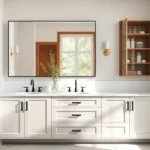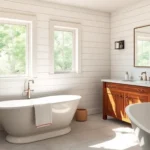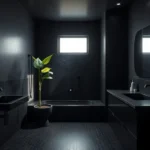We’ve all been there – frantically searching through cluttered bathroom cabinets for that one item we desperately need, only to find expired medications and mystery bottles taking up valuable space. Bathroom cabinet organization doesn’t have to be a nightmare that haunts your daily routine.
The truth is, a well-organized bathroom cabinet can transform your entire morning experience. When everything has its designated place, you’ll save precious time and reduce stress while creating a more functional space that actually works for your lifestyle.
Whether you’re dealing with a tiny powder room cabinet or a spacious vanity with multiple compartments, we’ve discovered proven strategies that’ll turn your chaotic storage into an efficiently organized system. From maximizing vertical space to implementing smart storage answers, these practical ideas will help you create a bathroom cabinet that’s both beautiful and brilliantly functional.
Assess Your Current Bathroom Cabinet Space and Storage Needs
Before diving into organizing answers, we need to understand what we’re working with and establish a clear foundation for our bathroom cabinet transformation.
Take Inventory of All Items Currently Stored
Remove everything from your bathroom cabinets and place items on a clean surface like your countertop or a towel on the floor. This complete emptying allows us to see exactly what we’re dealing with and prevents overlooking forgotten items tucked in back corners.
Sort items into categories such as medications, skincare products, hair care items, dental care supplies, and cleaning products. Creating these distinct groups helps us visualize how much space each category requires and identifies duplicate items we might not have realized we owned.
Check expiration dates on all products and medications during this sorting process. We often discover expired sunscreen from three summers ago or medication that’s no longer safe to use, which creates unnecessary clutter in our limited storage space.
Make three piles labeled “keep,” “donate,” and “discard” to streamline your decision making. Items we use daily or weekly go in the keep pile, while products we bought but never used might benefit someone else through donation.
Measure Cabinet Dimensions and Available Space
Measure the height, width, and depth of each cabinet compartment using a measuring tape to get precise dimensions. These measurements become crucial when selecting storage containers, shelving inserts, or drawer organizers that need to fit perfectly within your existing space.
Document shelf spacing between fixed shelves to understand vertical limitations for storage answers. Many bathroom cabinets have adjustable shelves, but knowing current spacing helps us plan for taller items like bottles and containers.
Note any obstacles like plumbing pipes, electrical outlets, or cabinet hardware that might interfere with storage placement. These elements often create dead space that we can work around with creative storage answers.
Create a simple sketch of your cabinet layout with measurements noted for reference while shopping for organizational products. This visual guide prevents purchasing items that won’t fit and saves multiple trips to the store.
Identify Problem Areas and Storage Challenges
Pinpoint areas where items frequently fall over or get pushed to the back and forgotten about. These trouble spots often occur in deep cabinets where items in front block access to products stored behind them, creating frustrating daily experiences.
Notice which products you struggle to reach on a regular basis, especially items stored on high shelves or in awkward corners. Daily use items that require climbing or stretching create inconvenience and often get abandoned in favor of more accessible alternatives.
Identify wasted vertical space between shelf tops and the items stored below them. Most bathroom cabinets have generous height that goes unused, representing missed opportunities for additional storage layers.
Recognize moisture prone areas where products might be exposed to steam and humidity from showers. Items stored near bathroom vents or in cabinets adjacent to shower areas may require different storage answers to prevent damage from condensation.
Declutter and Sort Items Before Implementing Organization Systems
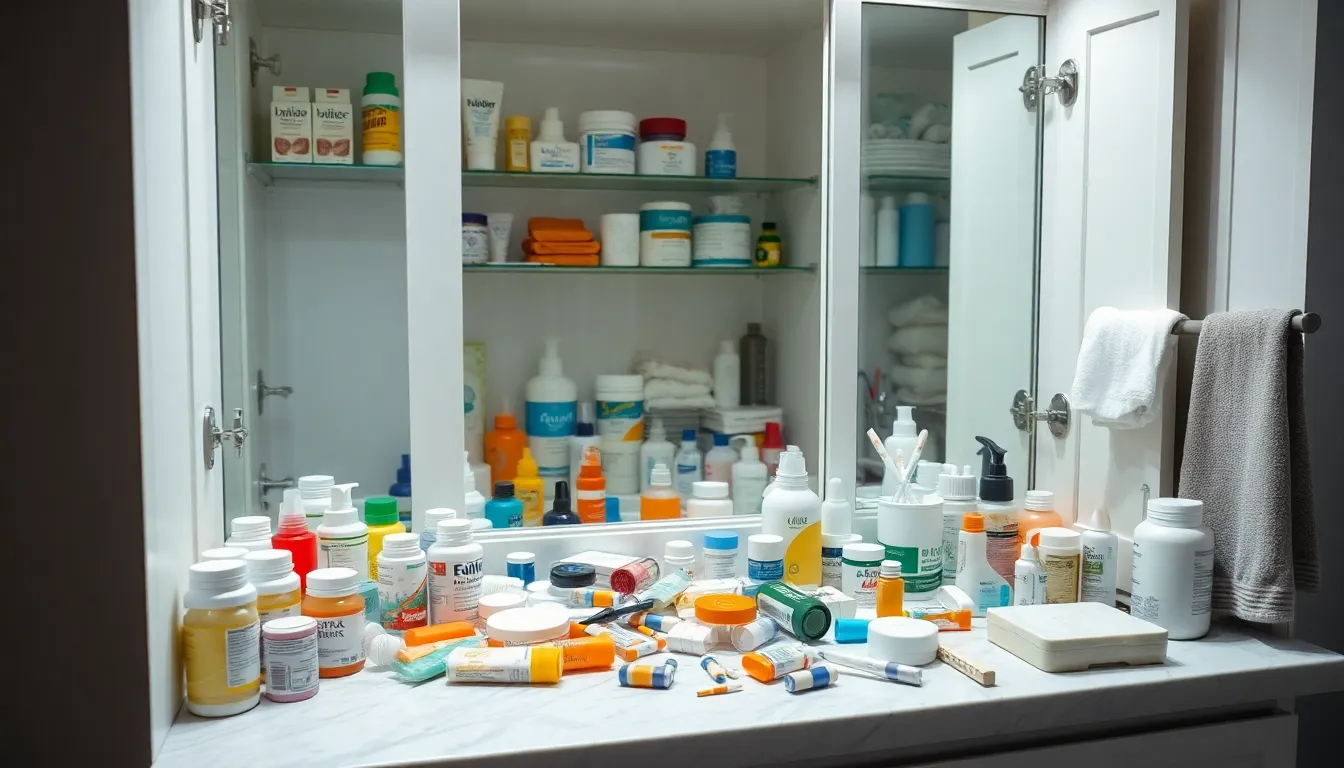
Now that we’ve assessed our space and identified problem areas, it’s time to tackle the contents of our bathroom cabinet systematically.
Remove Expired Products and Unused Items
Empty the entire cabinet to create a clean slate for our organization project. This complete removal allows us to thoroughly examine every item without missing anything tucked away in corners or behind other products.
Check expiration dates on all medications, skincare products, and cosmetics as we pull them out. Many people don’t realize that even unopened beauty products have shelf lives, and expired medications can lose effectiveness or become potentially harmful.
Dispose of damaged containers and products that have changed color, texture, or smell. These items not only take up valuable space but can also create hygiene concerns in our bathroom environment.
Set aside unused items that we’ve never opened or haven’t touched in over six months. These products often accumulate from gift sets, impulse purchases, or samples that seemed appealing at the time but don’t fit our actual routine.
Group Similar Items into Categories
Create distinct piles for medications, daily skincare, makeup, hair care, oral hygiene, and cleaning supplies. This categorization makes it easier to see exactly what we own and prevents duplicate purchases.
Use clear containers or temporary boxes to keep each category separate during the sorting process. Visual separation helps us maintain focus and prevents items from getting mixed back together.
Identify subcategories within larger groups, such as separating daily vitamins from prescription medications or organizing skincare by morning versus evening routines. This detailed sorting creates a foundation for our final storage system.
Keep first aid supplies together in their own designated group, including bandages, antiseptic, and emergency medications. These items need quick access during urgent situations.
Decide What Stays, Goes, or Gets Relocated
Designate frequently used items for prime real estate in our bathroom cabinet, focusing on products we reach for daily or multiple times per week. These should occupy the most accessible shelf space.
Move seasonal or occasional items to less convenient spots within the cabinet or consider relocating them to a linen closet or bedroom storage. Holiday skincare sets and special occasion makeup don’t need everyday accessibility.
Relocate items that don’t belong in the bathroom environment, such as nail polish that can be damaged by humidity or medications that require cool, dry storage conditions.
Create a donation pile for unopened, unexpired products that simply don’t work for our skin type or lifestyle. Someone else can benefit from these items rather than letting them clutter our space.
Establish a discard pile for anything expired, damaged, or contaminated. This includes old makeup brushes that can’t be properly cleaned, rusty containers, or products that have separated beyond repair.
Install Adjustable Shelving Systems for Maximum Flexibility
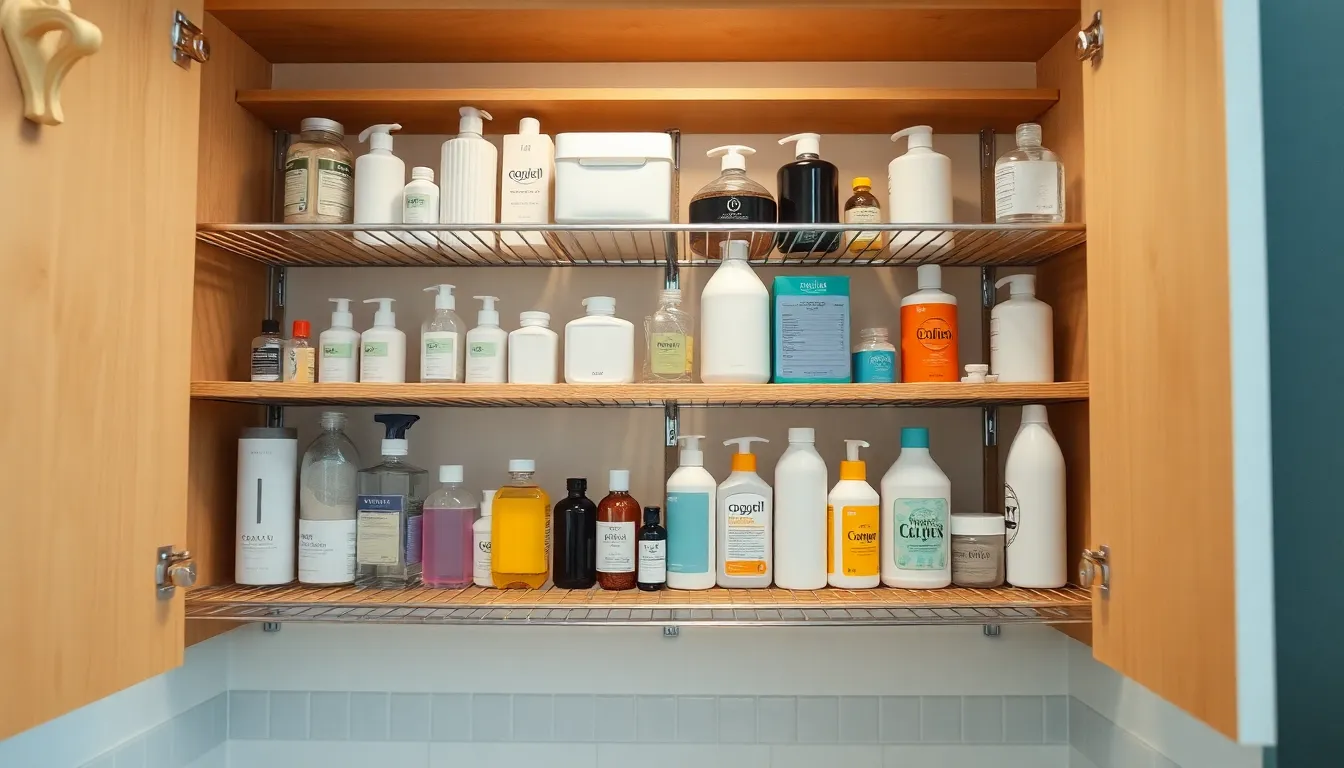
Adjustable shelving systems transform cluttered bathroom cabinets into organized storage spaces that adapt to your changing needs.
Choose Between Wire, Wood, or Plastic Shelf Options
Wire shelves offer excellent ventilation and prevent moisture buildup around bottles and containers. They’re lightweight and allow air circulation that keeps items dry in humid bathroom environments. These shelves work best for storing cleaning supplies and hair products that benefit from airflow.
Wood shelves provide a premium aesthetic that complements traditional bathroom designs. They support heavier items like large bottles and bulk supplies without sagging. Wood options require proper sealing to resist moisture damage in bathroom conditions.
Plastic shelves deliver budget-friendly versatility with easy cleaning and maintenance. They resist moisture naturally and won’t rust or warp over time. These shelves handle everyday toiletries and cosmetics effectively while matching modern bathroom styles.
Position Shelves Based on Item Heights and Frequency of Use
Daily essentials deserve placement at eye level for quick morning and evening access. Position toothbrushes, face wash, and medications where you can grab them without stretching or bending.
Tall bottles require adequate vertical clearance on lower shelves to prevent toppling. Measure your largest containers before setting shelf heights to ensure proper fit.
Small items work best on upper shelves where they won’t get lost behind larger products. Store backup supplies and seasonal items in these less accessible spots.
Heavy products belong on bottom shelves for safety and stability. Place bulk cleaning supplies and large shampoo bottles where they won’t fall and cause injury.
Consider Pull-Out Shelves for Deep Cabinets
Pull-out shelves eliminate the need to dig through deep cabinets to find items stored in the back. They bring everything forward with a simple sliding motion, making every product visible and accessible.
Deep cabinet spaces become fully functional with pull-out systems that extend completely outside the cabinet frame. You’ll use 100% of your storage depth instead of losing items in dark corners.
Installation flexibility allows you to retrofit existing cabinets with pull-out drawer systems. Most systems attach to existing shelf supports without major cabinet modifications.
Weight capacity varies by system, with heavy-duty options supporting cleaning supplies and bulk products. Choose pull-out shelves rated for your exact storage needs to ensure long-term durability.
Utilize Vertical Storage Solutions to Maximize Cabinet Height
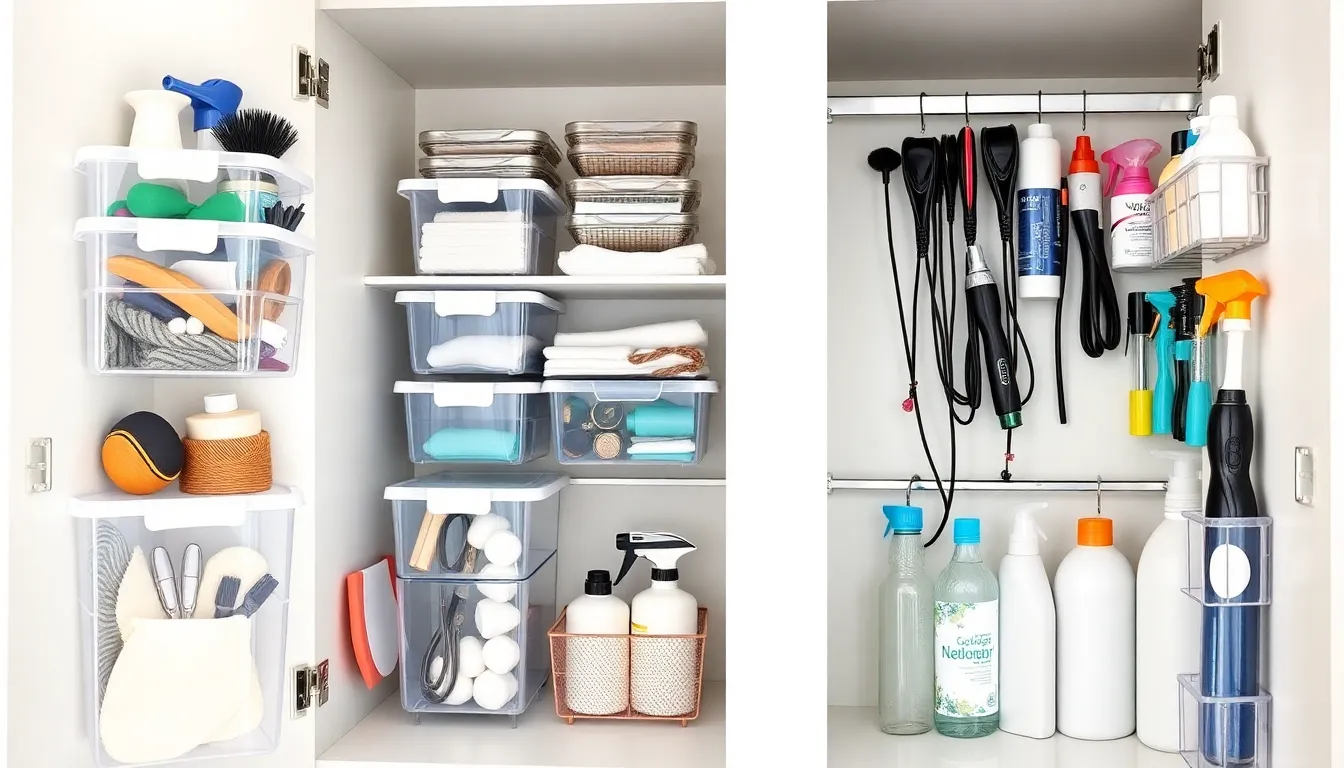
Most bathroom cabinets offer important untapped vertical space that we can transform into organized storage areas. Let’s explore three proven strategies to make the most of every inch from floor to ceiling.
Add Stackable Storage Bins and Containers
Stackable storage bins create multiple levels within your cabinet space, effectively doubling or tripling your storage capacity. Clear containers work exceptionally well for this purpose since they allow us to see contents at a peek without removing lids or labels. We recommend using these transparent bins for smaller items like cotton balls, Q-tips, hair accessories, and travel-sized toiletries.
Labelled containers take organization one step further by ensuring every family member can quickly identify and return items to their designated spots. Position heavier stackable bins on lower shelves and lighter ones toward the top to maintain stability. Consider investing in containers with interlocking edges or grooved bottoms that prevent sliding and create secure towers of storage.
Install Over-the-Door Organizers on Cabinet Doors
Cabinet doors represent prime real estate that often goes completely unused in bathroom storage systems. Over-the-door hooks and organizers instantly add storage without requiring any permanent modifications to your existing cabinets. These answers work particularly well for items we use regularly but don’t want cluttering our countertops.
Hair dryers, curling irons, and styling tools fit perfectly in over-the-door organizers with dedicated compartments and heat-resistant materials. Cleaning supplies also benefit from door-mounted storage since we can group spray bottles, scrub brushes, and microfiber cloths in one accessible location. Choose organizers with adjustable hooks that accommodate different door thicknesses and won’t damage your cabinet finish.
Use Tension Rods for Hanging Spray Bottles and Tools
Tension rods offer an ingenious solution for utilizing the often-wasted space between shelves in bathroom cabinets. Installing these adjustable rods requires no tools or hardware while creating instant hanging storage for spray bottles, cleaning tools, and other items with handles or loops.
Position tension rods at varying heights to accommodate different bottle sizes and tool lengths. We’ve found that placing one rod higher for tall spray bottles and another lower for smaller items maximizes efficiency. This hanging system keeps items off shelves entirely, freeing up flat surfaces for stackable containers and preventing bottles from tipping over when we reach for other supplies.
Create Designated Zones for Different Product Categories
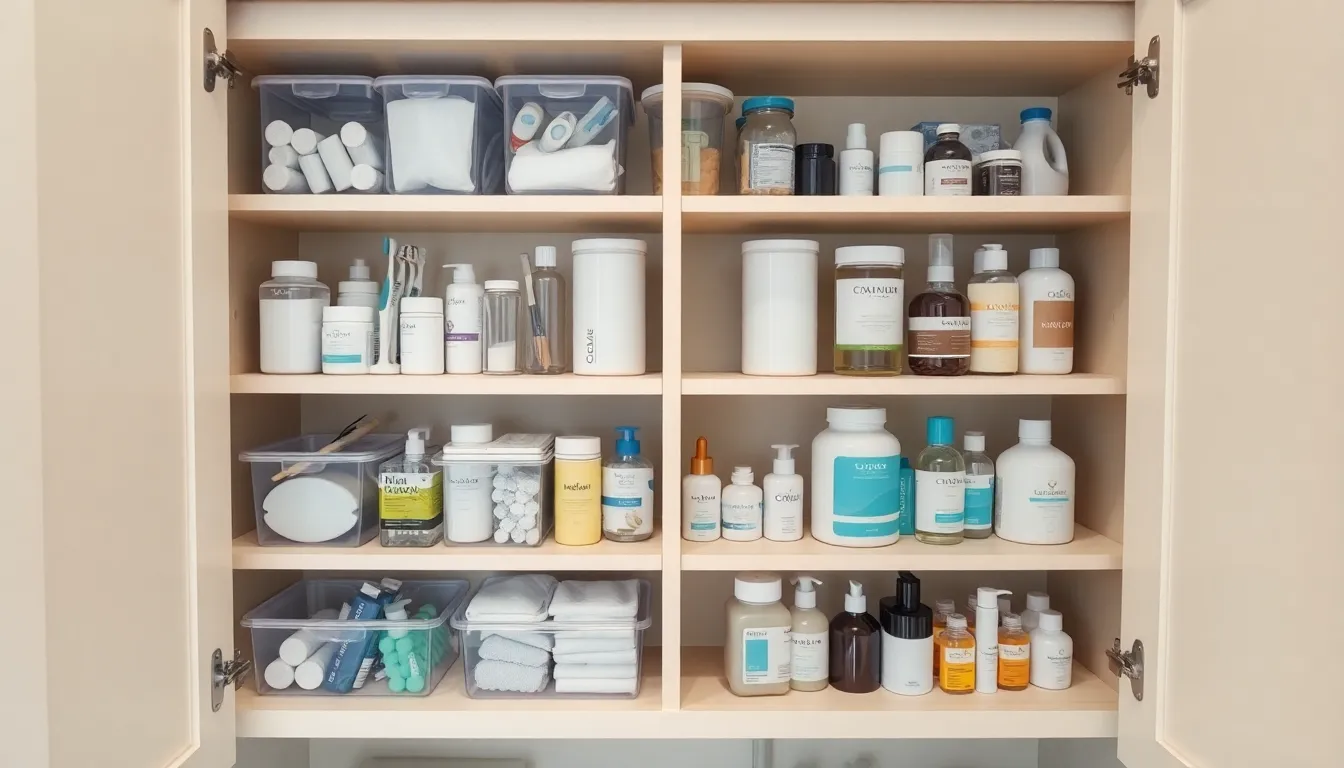
We’ll transform our bathroom cabinet into an efficient system by grouping similar items together and assigning them exact locations based on frequency of use. This zone-based approach reduces search time and prevents mixing of unrelated items.
Establish a Daily Essentials Zone at Eye Level
Position our most frequently used items between shoulder and eye level for optimal accessibility. Toothbrushes, daily medications, and everyday makeup should occupy these prime real estate shelves since we reach for them multiple times per day. Skincare products like cleansers and moisturizers that we use during our morning and evening routines deserve spots in this convenient zone.
Place clear containers or drawer dividers in this area to maintain organization without sacrificing visibility. Small bins work perfectly for keeping lip balms separate from vitamins while ensuring everything stays in its designated spot. Modular organizers allow us to customize compartments based on our exact daily essentials collection.
Keep backup items for daily products on nearby shelves to streamline restocking. When our toothpaste tube runs low, having the replacement within easy reach prevents disruption to our routine. This strategy works especially well in small bathrooms where every inch counts for efficiency.
Designate Lower Areas for Bulk Items and Cleaning Supplies
Store heavier and bulkier items on lower shelves where they’re stable and easily accessible. Extra toilet paper, large bottles of shampoo, and cleaning supplies belong at ground level since their weight makes upper placement impractical. Bulk purchases of body wash and lotion tubes fit naturally in these spacious lower compartments.
Use deep lower cabinets for items we don’t need to see daily but want within reach. Cleaning supplies like bathroom scrubbers and disinfectants stay organized in labeled bins on bottom shelves. Large bottles of hydrogen peroxide and rubbing alcohol find secure homes where they won’t tip over or crowd our daily essentials.
Group cleaning supplies together using bins or caddies to prevent spills from affecting other products. Separate containers for toilet bowl cleaners and surface sprays keep chemicals organized while protecting nearby items. This approach makes cleaning day more efficient since we can grab the entire caddy when needed.
Reserve Upper Shelves for Seasonal or Rarely Used Products
Allocate top shelf space for products we use less than once per month. Holiday themed hand towels, seasonal bath bombs, and special occasion makeup collections belong in these harder to reach areas. Guest supplies like travel sized toiletries and extra washcloths stay organized but out of our daily workflow.
Store backup supplies for products that don’t expire quickly on upper shelves. Extra bars of soap, unused razors, and sealed packages of cotton swabs can wait patiently above until we need them. Seasonal cosmetics like sunscreen or holiday themed nail polish make perfect upper shelf residents.
Use labeled containers on high shelves to identify contents without having to reach up and search. Clear bins with labels facing forward let us see what’s available at a peek. Stacking bins maximize vertical space while keeping seasonal items separated by category or time of year.
Implement Clear Storage Containers for Easy Visibility
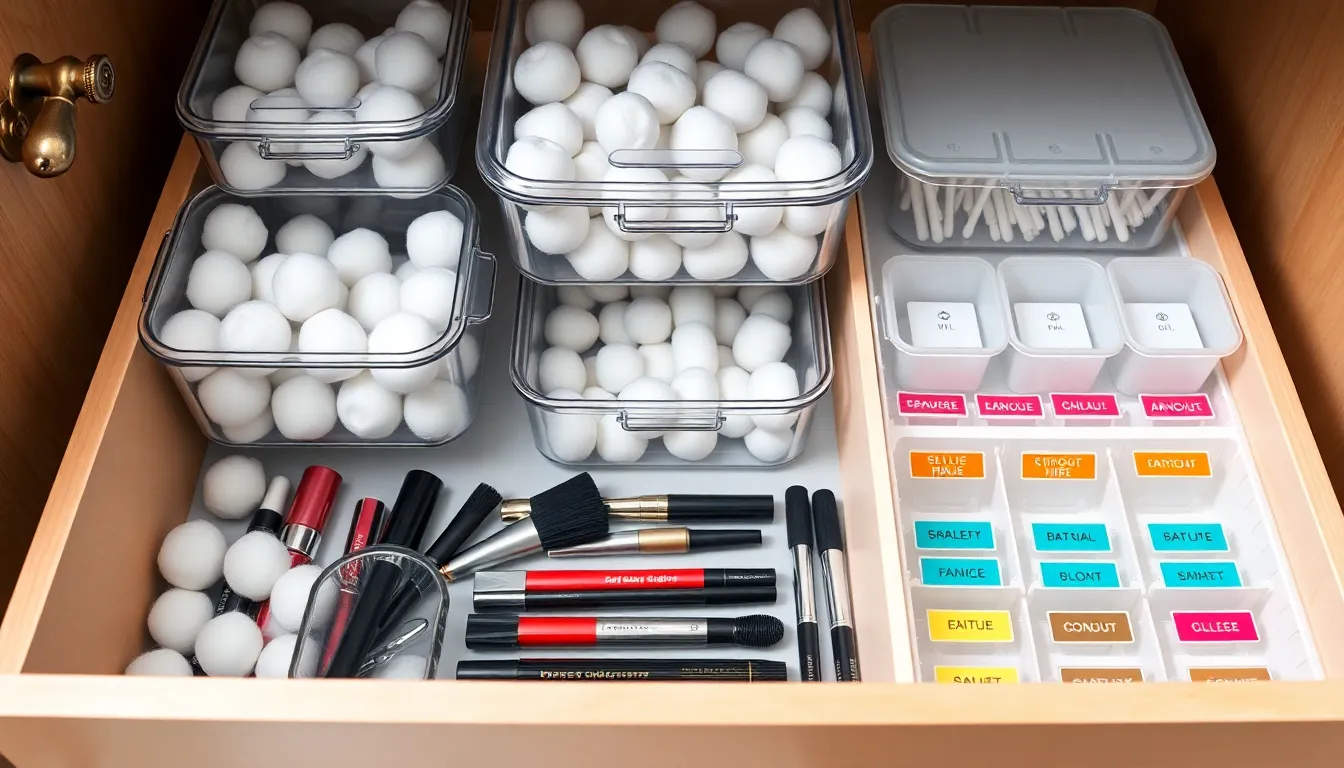
Clear storage containers transform bathroom cabinet organization by providing instant visibility of contents while maintaining a clean, uniform appearance. We’ve found that this simple switch from opaque containers dramatically reduces time spent searching for items and helps prevent duplicate purchases.
Choose Airtight Containers for Cotton Balls and Swabs
Airtight containers excel at preserving the freshness and cleanliness of cotton balls, swabs, and other hygiene essentials. Moisture protection becomes crucial in bathroom environments where humidity levels fluctuate throughout the day. These sealed containers prevent cotton products from becoming damp or collecting dust particles that naturally accumulate in cabinet spaces.
Small airtight containers work perfectly for organizing different types of cotton products separately. We recommend selecting containers with wide openings for easy access while maintaining proper seals. Clear airtight options allow us to monitor supply levels without opening containers unnecessarily.
Use Drawer Organizers for Small Items and Accessories
Drawer organizers create designated compartments for makeup brushes, tweezers, nail tools, and other small accessories that typically create cabinet chaos. Compartmentalized systems prevent items from shifting around when doors open and close. These organizers maximize drawer space efficiency by utilizing every available inch through strategic divider placement.
Adjustable drawer organizers adapt to different item sizes and cabinet configurations. We suggest measuring drawer dimensions before purchasing to ensure proper fit and maximum storage potential. Multiple organizer trays stack vertically in deeper drawers to create additional storage layers.
Label All Containers for Quick Identification
Labels eliminate guesswork and maintain organizational systems over time by clearly identifying container contents. We’ve discovered that consistent labeling prevents family members from placing items in incorrect locations. Clear, readable labels save precious morning routine minutes by directing us straight to needed products.
Waterproof labels withstand bathroom humidity and cleaning routines without peeling or fading. We recommend using uniform label styles throughout the cabinet for a cohesive, professional appearance. Color coded labels can further enhance organization by grouping related product categories together.
Add Lighting Solutions to Improve Cabinet Visibility
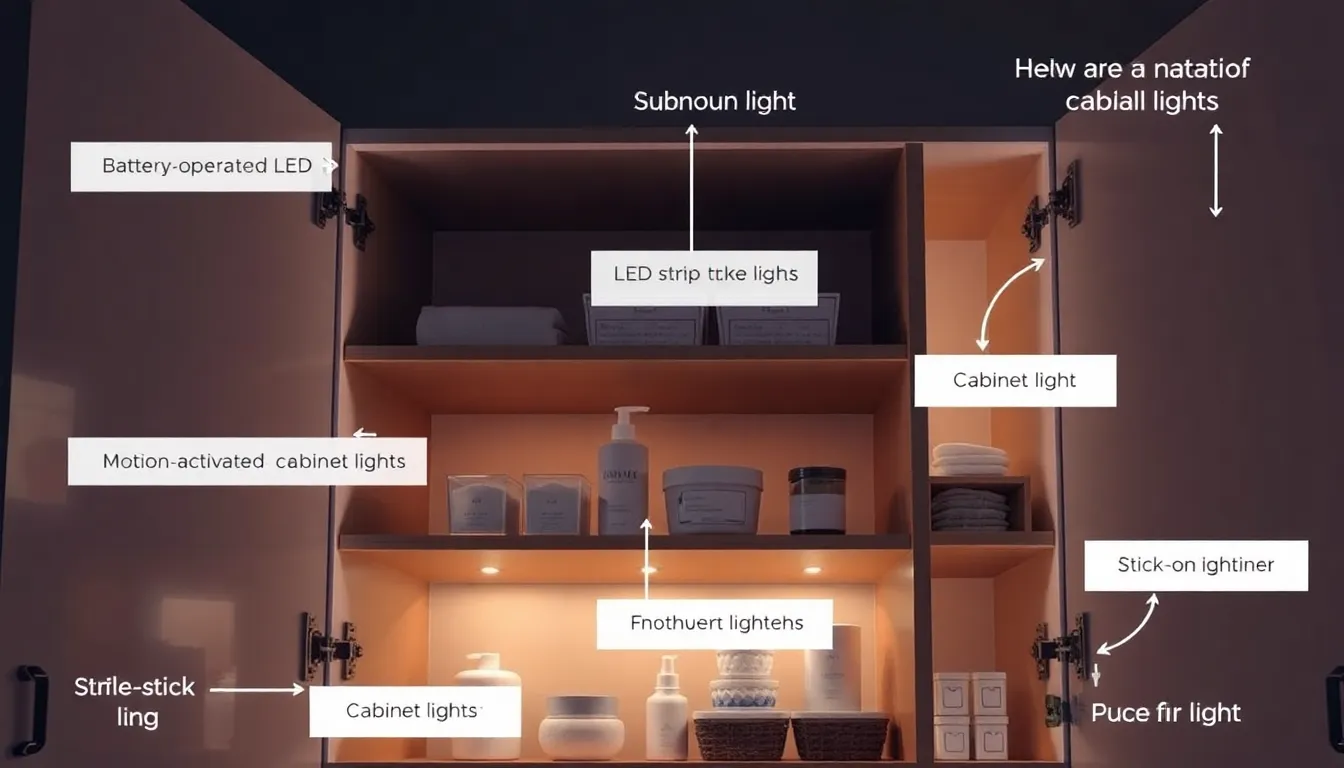
Poor lighting transforms even the most organized bathroom cabinet into a frustrating search zone. We can eliminate this problem by incorporating strategic lighting that illuminates every corner and shelf.
Install Battery-Operated LED Strip Lights
Battery-operated LED strip lights offer the perfect solution for cabinet lighting without complex electrical work. These flexible strips attach easily to shelves and provide consistent illumination across the entire cabinet width. We recommend positioning them along the front edge of each shelf to eliminate shadows behind taller items.
Installation takes just minutes with adhesive backing that sticks securely to clean surfaces. Most battery-operated options run for 30 to 50 hours on a single set of batteries, making them both energy efficient and cost effective. The cordless design means we can place them anywhere without worrying about power outlets or extension cords.
Choose warm white LEDs for a comfortable glow that doesn’t strain our eyes during early morning routines. Many models include dimming features that adjust brightness based on ambient light conditions in the bathroom.
Use Motion-Activated Cabinet Lights
Motion-activated cabinet lights automatically illuminate when we open cabinet doors, providing instant visibility without fumbling for switches. These sensors detect movement within a 120-degree range and activate lights immediately upon door opening. We save energy since the lights turn off automatically after 15 to 30 seconds of no motion.
Battery-powered motion sensors eliminate the need for rewiring existing cabinets. The magnetic mounting system allows us to reposition lights easily as our storage needs change. Most units feature adjustable sensitivity settings that respond only to deliberate cabinet access rather than nearby movement.
Smart motion lights often include daylight sensors that prevent activation during bright daytime hours. This feature extends battery life significantly while ensuring lights only function when needed for visibility enhancement.
Consider Stick-On Puck Lights for Dark Corners
Stick-on puck lights excel at targeting exact dark areas within bathroom cabinets that strip lights might miss. We can position these compact circular fixtures directly above problem zones like deep corners or behind tall bottles. Their focused beam pattern provides concentrated illumination exactly where we need it most.
The low profile design means puck lights won’t interfere with closing cabinet doors or accessing stored items. Installation requires no tools since they adhere with strong 3M adhesive that withstands bathroom humidity. Each light typically measures 3 to 4 inches in diameter, making them perfect for tight spaces between shelves.
Touch-activated models let us control individual lights with a simple tap rather than relying solely on timers or motion sensors. We can create custom lighting zones by mixing different activation methods throughout the same cabinet system.
Maintain Your Organized Bathroom Cabinets Long-Term

Maintaining our newly organized bathroom cabinets requires consistent effort and smart habits to prevent clutter from returning. Establishing sustainable routines ensures our organization systems continue working effectively for months and years ahead.
Establish a Monthly Review and Decluttering Routine
Schedule a dedicated monthly session to review and declutter your bathroom cabinets completely. During these sessions, we systematically check expiration dates on medications and toiletries to identify products that need disposal. Remove empty containers immediately and discard any unused or outdated products that we’ve accumulated over the past month.
Focus on high turnover areas where products tend to accumulate quickly, such as skincare zones and daily essentials sections. We examine each category methodically, looking for duplicates or products that no longer serve our needs. Wipe down shelves and containers during this monthly routine to maintain cleanliness and prevent moisture buildup.
Document what we’re removing to identify patterns in our purchasing habits and prevent future overcrowding. This monthly audit helps us recognize which products we actually use versus those that sit untouched, leading to smarter shopping decisions moving forward.
Return Items to Their Designated Spots After Each Use
Commit to the “one touch rule” where we immediately return each item to its designated location after using it. This simple habit prevents the gradual accumulation of clutter that can undo our organization efforts within weeks. Train all household members to follow this system consistently, making it a non negotiable part of our daily routines.
Create visual reminders in the form of labels or photos showing where items belong, especially helpful for shared bathroom spaces. We find that clear containers and designated zones make it easier to remember proper placement, reducing the mental effort required to maintain organization.
Address problem items immediately when we notice certain products consistently ending up in wrong locations. Sometimes this indicates our storage solution isn’t practical for that exact item, requiring us to adjust the system rather than fight against natural usage patterns.
Adjust Organization Systems as Needs Change
Evaluate our storage answers quarterly to ensure they still match our current product collections and lifestyle needs. As household needs evolve, we add or remove organizers, change labels, or reconfigure shelf layouts to accommodate new products or changed usage patterns.
Respond to seasonal changes by rotating products based on usage frequency throughout the year. We move summer skincare items to easily accessible spots during warmer months, then relocate them for winter products when seasons change.
Upgrade containers and organizers when we notice our current answers aren’t working effectively anymore. Sometimes our product quantities change significantly, requiring larger bins or additional dividers to maintain proper organization. Flexible systems that can adapt to changing needs prove most valuable for long term success.
Conclusion
We’ve covered the essential strategies to transform your bathroom cabinet from chaotic clutter to organized efficiency. These proven techniques will save you precious time during your daily routine while reducing the stress of searching for misplaced items.
Remember that successful bathroom cabinet organization isn’t a one-time project—it’s an ongoing commitment. The systems we’ve outlined will only remain effective if you maintain them through regular decluttering and consistent daily habits.
Start with one cabinet at a time and carry out these answers gradually. Your future self will thank you every morning when you can quickly locate exactly what you need without the frustration of digging through disorganized shelves.
Frequently Asked Questions
How often should I organize my bathroom cabinet?
Perform a monthly review to check expiration dates and remove unused products. Implement the “one touch rule” by returning items to their designated spots immediately after use. Conduct quarterly adjustments to accommodate changing needs, rotate seasonal items, and upgrade containers when necessary for long-term organization success.
What’s the best way to maximize vertical space in bathroom cabinets?
Use stackable storage bins to create multiple levels and increase storage capacity. Install over-the-door organizers for frequently used items. Add tension rods between shelves to hang spray bottles and tools. Consider adjustable shelving systems to customize spacing based on your item heights and storage needs.
How do I create an effective zone system in my bathroom cabinet?
Establish a “Daily Essentials Zone” at eye level for frequently used items. Place bulk items and cleaning supplies on lower shelves. Reserve upper shelves for seasonal or rarely used products with labeled containers. This zone-based approach streamlines access and maintains order throughout your cabinet space.
What storage containers work best for bathroom cabinets?
Use clear storage containers for easy visibility and to prevent duplicate purchases. Choose airtight containers for cotton balls and swabs to protect from moisture. Implement drawer organizers for small items and accessories. Ensure all containers are labeled with waterproof labels to withstand bathroom humidity effectively.
How can I improve lighting in my bathroom cabinet?
Install battery-operated LED strip lights on shelves to eliminate shadows. Use motion-activated cabinet lights for automatic visibility when doors open. Add stick-on puck lights in dark corners for focused illumination. These lighting solutions improve visibility and make it easier to maintain your organized cabinet system.
What should I do with expired medications and products?
Create three piles: “keep,” “donate,” and “discard” during your assessment. Check expiration dates on all medications, skincare products, and cosmetics. Dispose of expired or damaged items safely. Set aside unused products in good condition for donation to reduce clutter and maximize available storage space.
How do I measure my cabinet space for storage solutions?
Document all shelf dimensions and spacing accurately. Note any obstacles that may interfere with storage placement. Identify problem areas where items frequently fall over or are hard to reach. Recognize wasted vertical space and moisture-prone areas to select appropriate storage solutions that fit properly.
What are the benefits of pull-out shelves for deep cabinets?
Pull-out shelves enhance accessibility by bringing items forward and utilizing full storage depth. They can be retrofitted into existing cabinets without major modifications. These systems provide installation flexibility and should be selected based on weight capacity requirements to ensure durability and safe storage.
How do I prevent my bathroom cabinet from becoming cluttered again?
Establish consistent monthly decluttering routines and implement the “one touch rule” for immediate item replacement. Create visual reminders to maintain organization systems. Adjust your organization quarterly to accommodate changing product collections and needs. Group similar items together to prevent duplicate purchases and maintain order.
What’s the first step in organizing a bathroom cabinet?
Begin by completely emptying your cabinet and taking inventory of all items. Sort everything into categories like medications, skincare, and cleaning supplies. Check expiration dates and create “keep,” “donate,” and “discard” piles. This assessment provides a solid foundation for implementing effective storage solutions.


